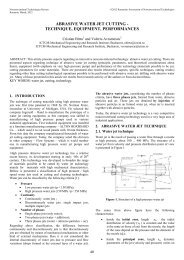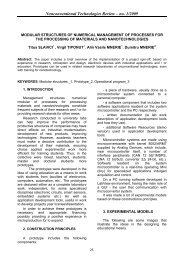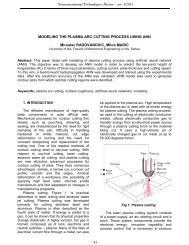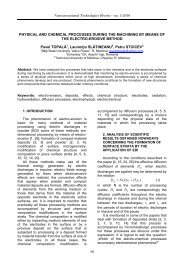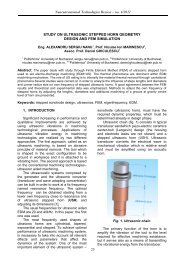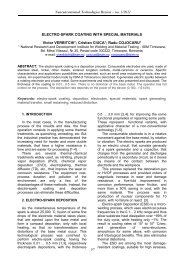ANALYSIS OF THE LASER MARKING TECHNOLOGIES - Revtn.ro
ANALYSIS OF THE LASER MARKING TECHNOLOGIES - Revtn.ro
ANALYSIS OF THE LASER MARKING TECHNOLOGIES - Revtn.ro
Create successful ePaper yourself
Turn your PDF publications into a flip-book with our unique Google optimized e-Paper software.
Nonconventional Technologies Review – no.4/ 2008applications, the following factors shall befocused:• laser specifications;• optical delivery system;• cont<strong>ro</strong>l system and software;• ease of operation;• manufacturer's performance record;• price.The laser specifications of different types oflasers are different. For CW lasers, the majorspecifications should include wavelength,average laser power, power stability, beamquality factors and Q-switch elementperformance (maximum pulse repetition rate,minimum pulse duration, laser peak power).For pulsed lasers, the specifications shouldinclude wavelength, average laser power,maximum peak power, maximum energy perpulse, pulse repetition rate, pulse duration,pulse-to-pulse stability, and beam qualityfactors.There are many types of optical deliverysystems. For mask marking p<strong>ro</strong>cesses, thesystems may include beam expander,homogeniser, CCD camera and monito<strong>ro</strong>r/and mic<strong>ro</strong>scope, and p<strong>ro</strong>ject lens. Thep<strong>ro</strong>ject lens, together with the beam sizeentering it, determines how big a mark can beobtained per pulse.For beam deflected marking system, thesystem may include beam expander, CCDcamera and monitor or/and mic<strong>ro</strong>scope,scanner, fibber optics, and lens. The lens arevery important in determining focused spotsize, marking field, minimum marked-linewidth and power density on the workpiece.The scanner together with the markingsoftware determines the scanning speed.Cont<strong>ro</strong>l systems and software are verydifferent for different laser marking systems.The cont<strong>ro</strong>l system may include feeding ofworkpiece, cont<strong>ro</strong>l of beam on/off, andinterfaces among computer, laser generator,stage, and p<strong>ro</strong>tection/alarm systems. Themarking software should be easy toimplement in a user's system and to p<strong>ro</strong>gramconveniently.5. <st<strong>ro</strong>ng>MARKING</st<strong>ro</strong>ng> QUALITYCHARACTERISTICSThe quality of a mark is assessed by itslegibility characteristics such as markcontrast, mark width, mark depth, spattering,20and mic<strong>ro</strong>cracks [2], [7], [8]. Thecharacteristics are usually evaluated usingcomplementary techniques such as opticalmic<strong>ro</strong>scopy, ult<strong>ro</strong>sonics mic<strong>ro</strong>scopy, elect<strong>ro</strong>nmic<strong>ro</strong>scopy, surface <strong>ro</strong>ughness measurement,and contrast evaluation devices. Theacceptance of level of each of thesecharacteristics generally depends on themanufacturer's requirements.Mark width refers to the width of the linesegment that forms a character. With themask image marking, the mark width in thecharacters is essentially determined by themask geometry and the lens imaging quality.It can be as small as a few mic<strong>ro</strong>-meters,which can only be read under a mic<strong>ro</strong>scope.In beam deflected marking, the line width ismainly determined by the focused beam spotsize, which varies between 20 - 100 µm.Other parameters such as scanning speed,power density and material p<strong>ro</strong>perties alsoaffect the line width. A toolmaker’smic<strong>ro</strong>scope or Talysurf surface texturemeasuring equipment are used for the linewidth measurement.Marking depth depends on energy density,types of materials and the beam/materialinteraction time. In mask marking, thevaporization depth is often determined by thethickness of paint or oxidation layer. It istypical of a few mic<strong>ro</strong>ns to several tens ofmic<strong>ro</strong>ns.In beam deflected marking, greater depth ofpenetration into the material can be achievedvarying between a few mic<strong>ro</strong>ns to severaltens of a millimeter. A further enhancement ofthe effect on the material can be realized bythe supply of gases such as oxygen orcompressed air, which assist materialremoval.Marking contrast is the visual differencebetween the apparent brightness of themarked surface and unmarked surface of aworkpiece.The sharpness or resolution of the markededges affects the marking contrast. Thisparameter is particularly important in marking“bar code”, as poor edge sharpness may failbar code reader. High peak power or powerdensity p<strong>ro</strong>duces better edge resolution.



